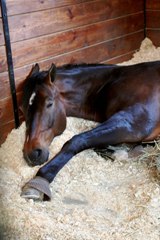Equine herpesvirus (EHV) is both clinically and economically important worldwide. Currently there are nine different herpesviruses that are recognised (EHV-1 to EHV-9). However, the most significant types are EHV-1 and EHV-4.
The virus is endemic within the horse population in most countries throughout the world. EHV-1 is the most significant of the equine herpesviruses, as it is responsible for causing respiratory disease, abortion (including outbreaks), early neonatal death of foals and neurologic disease. However, EHV-4 is also associated with respiratory disease and, less commonly, abortion. In any given outbreak of EHV, clinical signs are usually limited to one manifestation of the disease.
Clinical Signs
There is an incubation period of 2-10 days after exposure, prior to the onset of clinical signs of respiratory or neurologic disease. The abortion syndrome is the exception, as abortion can occur up to four months after exposure to the virus. After a horse begins to show clinical signs of disease, they can continue to shed the virus from the nasal passages, so when they cough or snort, for a further two to three weeks. Therefore, horses showing clinical signs consistent with equine herpesvirus infection should be isolated from non-affected horses for four weeks after the horse stops showing clinical signs.
Affected horses have a fever, which may be the only clinical sign and can go undetected if the horse’s temperature is not taken routinely. However, horses with a fever often become inappetant and go off their feed. These signs usually precede the development of other clinical signs.
Respiratory disease caused by EHV most commonly affects young horses, such as weanlings and yearlings. It is responsible for some outbreaks of respiratory disease at training facilities and in horses that have attended competitions. Older horses can also have the virus, but transmit it without showing clinical signs. The signs include bilateral nasal discharge and a cough. Recovery usually occurs within 8-10 days of the onset of clinical signs, but a secondary bacterial infection can prolong the course of disease and complicate it.
Neurological disease, also known as EHV-1 myeloencephalopathy, can occur sporadically, affecting just one or two horses, or can be associated with an outbreak of neurological disease in a group of horses. Respiratory disease may or may not have been observed on the property prior to the onset of neurological disease. Affected horses show weakness and uncoordination (ataxia), which is typically more severe in the hindlimbs than the forelimbs. They can become recumbent (unable to get up). Another sign includes urine retention; the horse is observed to have not urinated for several hours. Most clinical signs stabilise rapidly and begin to improve within hours. However, some horses do continue to deteriorate. Horses that remain standing can have a complete recovery within weeks to months. Control of urination typically returns prior to the resolution of limb signs. The clinical signs are due to infection of the blood vessels within the neurological system, usually the spinal cord.
Abortion due to EHV-1 occurs as a result of infection of the blood vessels of the placenta. As a result of the infection, the placenta detaches and abortion ensues. Most mares abort in the last trimester of pregnancy, that is 8 to 11 months of gestation. One mare in a group may be affected or there may be an ‘abortion storm’, where up to 50% of mares in a group can abort. There can be no warning signs. The aborted material is infectious for other mares and the mare that aborted can excrete virus in her nasal secretions, so the affected mare should be isolated and all aborted materials should be disposed of with care, so as not to expose other pregnant mares to it.
Foals can be infected whilst still in the uterus. They are usually abnormal from birth, and show signs of weakness, jaundice, respiratory distress, and neurological signs. Affected foals usually die within a few days of birth, succumbing to overwhelming respiratory disease.
Diagnosis
It is difficult to make a definitive diagnosis based upon the clinical signs alone, as there are many causes of the above clinical signs described. Therefore, it is necessary to perform laboratory tests to make the diagnosis. There are several tests available, which include:
-
Virus isolation from blood
-
Virus isolation from a nasopharyngeal swab
-
Identification of the virus by PCR (polymerase chain reaction – identifies genetic material from the virus) from a naspharyngeal swab
-
Serology to identify antibodies in the blood against herpesvirus
*The initial blood sample may show a high antibody titre (count) which is suggestive of infection, but two samples taken two weeks apart, showing an increasing antibody titre, confirms the diagnosis.
Treatment
There is no specific treatment for herpesvirus infection. Treatment is aimed at supporting the horse through medication and the provision of nursing care, depending upon the manifestation of the disease affecting the horse. Mares that abort are generally well in themselves and require no further attention, unless they retain the fetal membranes. Horses with respiratory signs may require anti-inflammatory medication (e.g. phenylbutazone {bute}). They are at risk of developing a secondary bacterial infection, due to suppression of the local immune response in the respiratory tract by the virus. Certain cases may require antibiotics to treat or prevent this secondary infection, but this is certainly not indicated in every case. Horses affected by the neurologic form of the disease require the most care, such as provision of food and water to if they are recumbent (down), catheterisation of the bladder if they are unable to urinate, regular turning if they are recumbent, and anti-inflammatory medication. These horses can be quite intensive to manage and may benefit from hospitalisation for proper care.
Prognosis
Horses with neurological symptoms may take several weeks to months to fully recover, and occasionally horses have persistent neurological deficits for the rest of their lives. Horses that are recumbent for prolonged periods (days) have a poor prognosis for recovery. Horses with uncomplicated respiratory disease have an excellent prognosis, as do mares that abort. However, horses that recover from the disease usually develop a latent infection that can persist for life. In times of stress, such as other illness or long-distance transport, latently infected horses can shed infection. They may or may not show clinical signs at this time, but are a source of infection for naive horses that have not been exposed to the virus before. Thus, competitions are an ideal place for the spread of virus, as horses are stressed by being travelled, often long distances, and by the new and unfamiliar environment. This suppresses their immune system, resulting in re-activation of the previously latent virus and the spread of the virus to other horses.
Vaccination
There is one vaccine available in Australia against equine herpesvirus, called Duvaxyn EHV-1,4, which protects against EHV-1 and EHV-4. It can be administered to any horse, but is particularly recommended for broodmares, where it is advised that it is administered at 5, 7 and 9 months of gestation to help prevent abortion due to EHV. However, it does not offer 100% protection. Also, the manufacturers of the vaccine do not claim protection against the neurologic form of the disease. Immunity resulting from both infection and vaccination is short-lived, only 3-5 months, after which time the horse is susceptible to infection again. Therefore, to maintain an adequate level of immunity, and remain realistic about the costs and practicality of repeatedly vaccinating the horse, it is recommended that horses are revaccinated every 6 months against EHV.
Biosecurity
Biosecurity is a topic in itself and is therefore too large an area to cover in this article. It includes biosecurity to prevent an outbreak when new horses are introduced onto a property, when large numbers of horses are brought together at events, such as shows and campdrafts, and also in the event of an outbreak. This topic can be discussed with your veterinarian as biosecurity protocols need to be tailored to suit each property and individual situation.










Testimonials
"David and his team treat their client’s animals as if they were their own and have helped me and my horses in some very stressful situations over the years, thankfully, always with a excellent outcome!"
"Thank you so much for the extra good care you took of Lilly ... I’ve always been extremely happy with Dave as our vet, I think he truly does a wonderful job, and you can really see how much he cares.”
"The fact that Dave has been my vet for many years speaks volumes. Dave has a very nice manner and deals with the horses in a calm and kind way. He always takes time to explain options and procedures and to advise on what he considers to be the best course of treatment."
"Although we may have moved, we would not consider using any other veterinarian other than David to care for our horses."